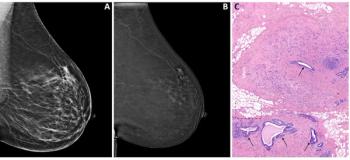
Adoption road to digital mammography need not be bumpy
As digital mammography finally gains momentum, a new paper documents several considerations to make transition efforts as seamless as possible.
As digital mammography finally gains momentum, a new paper documents several considerations to make transition efforts as seamless as possible.
Users had been reluctant to make the move to digital mammography until the long-awaited American College of Radiology Imaging Network Digital Mammographic Imaging Screening Trial reported in late 2005 that digital mammography is more accurate than screen-film mammography for some patients.
Users who did switch often found that digital mammography equipment could not be integrated easily into existing PACS networks.
The paper (J Am Coll Radiol 2007;3:178-183) specifies a number of steps to help smooth the transition:
- An evaluation of a facility's current screen-film situation, including the condition of the analog units, work flow, patient capacity, staffing, and PACS components, helps in understanding current status more clearly, said Dr. Margarita Zuley, an assistant professor of radiology at the University of Rochester in New York.
- The facility's goals for digital mammography should be determined. "Is the goal to improve efficiency in scheduling without increasing patient numbers, grow the business, create a versatile system, or integrate the mammography section into an otherwise filmless department?" Zuley said.
- Components of the digital imaging chain, network infrastructure, and PACS, as well as clinical aspects each part of the chain affects, must be understood to avoid unexpected frustration after the conversion is made.
- Education is required on the different acquisition, display, printing, and archival options to facilitate the choice of equipment that will meet the digital goals set forth previously. "An obstacle that everyone changing to digital mammography must face is what to do with prior analog mammograms," Zuley said. If priors can't be digitized, they can be hung on alternators adjacent to the workstation. This disturbs radiologist search patterns, however, and light emission from monitors is much lower than light emitted from alternators, so care must be taken to avoid reading soft-copy images in suboptimal lighting.
Even though digital mammography makes a huge impact on existing PACS, particularly for large facilities, because of the size of mammography files, Zuley sees definite trends developing.
"People are switching to digital mammography all at once now," she said. "Earlier, we saw people merely buying one unit here and there, but now we're seeing facilities totally switch over."
Zuley is also seeing a trend away from the purchase of the digital mammography acquisition unit and accompanying workstation from the same vendor.
"A best-of-breed approach is developing," she said. "We're starting to see people buying a workstation as an independent decision from the purchase of the acquisition unit, and both of those components might be from vendors that are third party to the in-house PACS."
Newsletter
Stay at the forefront of radiology with the Diagnostic Imaging newsletter, delivering the latest news, clinical insights, and imaging advancements for today’s radiologists.


























